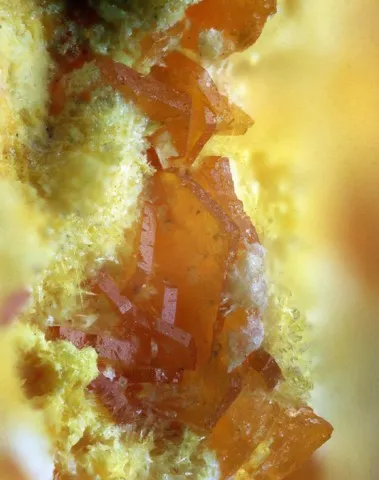AGRINIERITE
Class : Oxides and hydroxides
Subclass : Uranyl hydroxides
Crystal System : Monoclinic
Chemistry : (K2,Ca,Sr)U3O10 4H2O
Rarity : Very rare
Agrinierite is a hydrated oxide of uranium discovered during the exploitation of the uranium deposit of Margnac (Haute-Vienne, France), the only site in the world where it is known until today. It owes its name to Henri Agrinier, engineer at the Mineralogy Laboratory of the Atomic Commission of France. It appears at the periphery of uraninite nodules accompanied by other uranium oxides which result like it from the transformation of uraninite (becquerelite, schoepite, compreignacite, rameauite, etc...). Agrinierite occurs as small tabular orange crystals, transparent to translucent, submillimeter in size, frequently twinned which gives them a pseudohexagonal appearance.
Main photo : Agrinierite from Margnac, Haute-Vienne, France © Michel Bretheau
Agrinierite in the World
Twinning
This mineral twins with {110} as plane of composition.
Fakes and treatments
No fake reported for this mineral species.
Hardness : Undefined
Density : 5.7
Fracture : Irregular to conchoidal
Trace : Yellow
TP : Translucent to transparent
RI : Unmeasured
Birefringence : Unmeasured
Optical character : Uniaxial +
Pleochroism : None
Fluorescence : None
Solubility : None
Magnetism : None
Radioactivity : Very high

